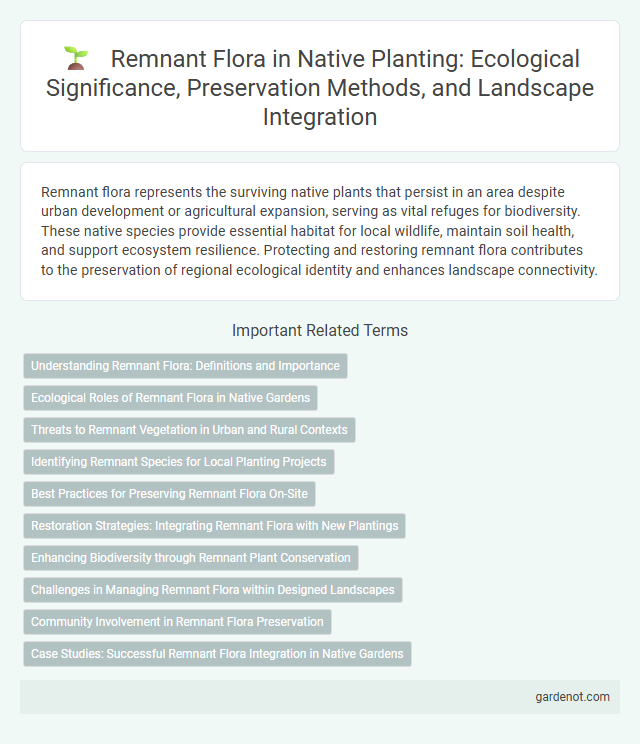Remnant flora represents the surviving native plants that persist in an area despite urban development or agricultural expansion, serving as vital refuges for biodiversity. These native species provide essential habitat for local wildlife, maintain soil health, and support ecosystem resilience. Protecting and restoring remnant flora contributes to the preservation of regional ecological identity and enhances landscape connectivity.
Understanding Remnant Flora: Definitions and Importance
Remnant flora refers to the native plant species that have persisted in a particular area despite environmental changes or human disturbances. These plants play a critical role in maintaining local biodiversity, supporting wildlife habitats, and preserving ecological balance. Understanding remnant flora helps guide effective conservation strategies and native planting efforts that restore and protect natural ecosystems.
Ecological Roles of Remnant Flora in Native Gardens
Remnant flora in native gardens serve crucial ecological roles, including supporting local biodiversity by providing habitats and food sources for native pollinators, birds, and insects. These plants contribute to soil stability and nutrient cycling, enhancing ecosystem resilience against erosion and climate variations. Integrating remnant flora helps restore natural ecological processes and maintains genetic diversity essential for adaptive plant populations.
Threats to Remnant Vegetation in Urban and Rural Contexts
Remnant flora in urban and rural areas face significant threats from habitat fragmentation, invasive species, and land development. Urban expansion reduces natural vegetation patches, disrupting ecosystems and diminishing biodiversity. In rural settings, agricultural activities and altered fire regimes further degrade remnant vegetation, compromising native plant communities and ecological resilience.
Identifying Remnant Species for Local Planting Projects
Remnant flora refers to native plant species that have persisted in an area despite environmental changes and development. Identifying remnant species for local planting projects involves surveying existing vegetation patches, consulting historical vegetation records, and engaging with local botanists to ensure the selection of ecologically appropriate plants. Utilizing these species supports biodiversity, enhances habitat restoration, and maintains the genetic integrity of native ecosystems.
Best Practices for Preserving Remnant Flora On-Site
Preserving remnant flora on-site involves minimizing soil disturbance and controlling invasive species to protect existing native plant root systems. Implementing buffer zones around remnant vegetation limits human impact and promotes natural regeneration. Regular monitoring and adaptive management ensure the continued health and resilience of these valuable native plant communities.
Restoration Strategies: Integrating Remnant Flora with New Plantings
Restoration strategies for native planting emphasize integrating remnant flora to enhance ecosystem resilience and biodiversity. Preserving and incorporating native remnants such as mature trees, understory plants, and soil seed banks improves habitat connectivity and supports local wildlife. Combining these remnants with new, site-appropriate plantings accelerates ecological recovery and stabilizes soil health in degraded landscapes.
Enhancing Biodiversity through Remnant Plant Conservation
Preserving remnant flora plays a crucial role in enhancing biodiversity by maintaining native plant species' genetic diversity and habitat complexity. These conserved patches support essential ecological processes and provide refuge for endangered wildlife, promoting ecosystem resilience. Strategies like controlling invasive species and restoring native plants in remnant areas optimize conservation outcomes and sustain ecosystem services.
Challenges in Managing Remnant Flora within Designed Landscapes
Remnant flora in designed landscapes faces significant challenges including limited genetic diversity, habitat fragmentation, and invasive species competition. Maintaining ecological integrity requires addressing soil degradation and microclimate changes that affect native plant survival. Effective management strategies involve careful monitoring, adaptive restoration techniques, and integrating native species that support local biodiversity.
Community Involvement in Remnant Flora Preservation
Community involvement plays a crucial role in the preservation of remnant flora by fostering local stewardship and awareness of native plant species. Volunteer programs and citizen science initiatives enable residents to monitor and protect these vital ecosystems, ensuring biodiversity conservation. Collaborative efforts between landowners, indigenous groups, and environmental organizations enhance the restoration and sustainable management of remnant plant communities.
Case Studies: Successful Remnant Flora Integration in Native Gardens
Case studies demonstrate that successful remnant flora integration in native gardens enhances biodiversity by preserving indigenous plant species adapted to local conditions. Projects in regions like the Australian bushland and California chaparral show improved ecosystem resilience and support for native fauna when remnant plants are incorporated. These efforts provide valuable blueprints for sustainable landscaping that maintains ecological heritage and promotes environmental balance.
Remnant flora Infographic

 gardenot.com
gardenot.com